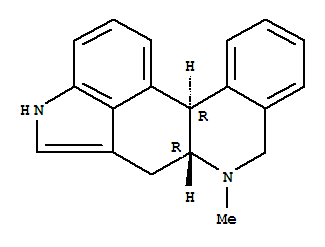| Identification |
| Name: | Indolo[4,3-ab]phenanthridine,4,6,6alpha,7,8,12beta-hexahydro-7-methyl-, (6aR,12bR)- |
| Synonyms: | 4,6,6alpha,7,8,12beta-Hexahydro-7-methylindolo(4,3-b)-phenanthridine; |
| CAS: | 100999-26-6 |
| Molecular Formula: | C19H18N2 |
| Molecular Weight: | 274.35962 |
| InChI: | InChI=1S/C19H18N2/c1-21-11-12-5-2-3-6-14(12)19-15-7-4-8-16-18(15)13(10-20-16)9-17(19)21/h2-8,10,17,19-20H,9,11H2,1H3/t17-,19-/m1/s1 |
| Molecular Structure: |
 |
| Properties |
| Melting Point: | 227-228ºC |
| Density: | 1.225 g/cm3 |
| Refractive index: | 1.697 |
| Water Solubility: | Soluble to 100 mM in DMSO |
| Solubility: | Soluble to 100 mM in DMSO |
| Appearance: | White Solid |
| Biological Activity: | Centrally active dopamine D 1 receptor agonist, selective over D 2 receptor sites. Stimulates adenylate cyclase in rat striatal homogenates with an EC 50 of 125 nM. Unlike SKF 38393 ((?-1-Phenyl-2,3,4,5-tetrahydro-(1H)-3-benzazepine-7,8-diol hydrobromide ), it exerts anti-Parkinsonian activity in animal models. |
| Safety Data |
| |
 |